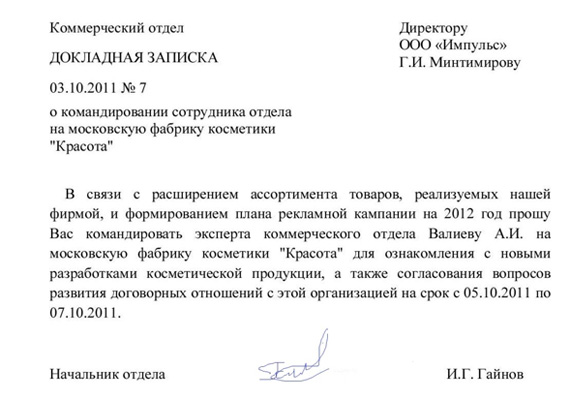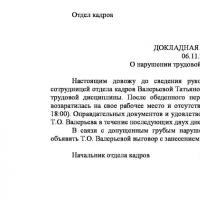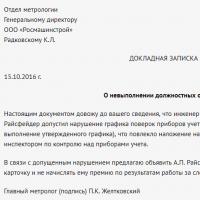Memo and memorandum - what is the difference between them
Correspondence is an important part of office life among various types of business communication. Its main tool is the well-known memos, which, depending on the content, are explanatory, memorandum, etc.
What is a memo and why is it needed?
According to its purpose, a memo is an informational message addressed to employees of one's own or other departments, management of departments, firms, divisions, branches. The list of topics covered in such documents is quite wide. The memos inform about the main events in the life of the company, about the implementation of current work, existing non-standard situations, contain complaints and ways to solve various production problems.
The main purpose of this kind of communication is coordination of various work issues in cases where an oral decision is not possible for any reason. A memo can also be used by management to draw up orders, which, unlike orders, are more informal.

Types and purpose of memorandums
A memorandum is the most popular type of memo, addressed to the head of the enterprise, chief accountant or any other senior employee. The main purpose of the report is informing superiors about any situation, the performance of work, as well as the preparation of recommendations for solving (eliminating) the problem, etc. A memorandum, unlike an official one, is always sent to a higher level and has legal force.
The most common type of memos are reports that inform management about the implementation of plans, the progress of current work, etc. Less often, reports are drawn up reporting on any unplanned situation that requires a response from higher management. The range of issues of such reports is quite wide: from information related to the main industry activities of the enterprise, to complaints about the organization of working conditions and reports on non-compliance with labor and financial discipline, official behavior, etc.

Memorandum - example
Compiling a proper memo
The structure of a memo requires the mandatory presence of the following elements:
- "Caps" indicating the organization, full name and position of the addressee, full name and position of the originator.
- A text block consisting of the title of the document ("Memorandum") and a summary of the situation, any actions, requests.
- Dates and signatures of the compiler (in one line, from left to right, the date, signature and full name of the compiler are indicated).
Also, a registration number may be indicated in the memo if, according to the rules of the enterprise, it is registered in the journal. It is important to note that, since memos are used only within the organization, the presence of forms is not a prerequisite, unless the rules of the enterprise require it. At the same time, some enterprises have their own letterhead with a logo, designed specifically for business correspondence.
How to write a report?
The memorandum is similar in structure to a memo. Its main difference is the addressee: if information in a memo can be sent to any other employee, then in a memorandum the message is addressed to a higher official.
Methods for preparing a memorandum differ depending on the purpose. In particular, an internal memorandum sent to management within the organization is drawn up in the same way as a memo. The difference lies in the content of the text block, which is called "Memorandum", contains a statement of the essence of the problem, proposals for its elimination or a description of measures already taken.
But when compiling an external memorandum, which is addressed to employees of other organizations, the rules are more stringent:
- The document is drawn up on the letterhead of the organization.
- The note is registered in the book of outgoing letters of the company, while the assigned registration number is indicated in the header of the note. Also, upon receipt of a note, it is registered as an incoming document in the organization of the addressee.
- The external note is signed, as a rule, by the head of the firm or his deputy. Signatures from heads of other departments may also be required when sending.
- The date of the note is the date of its signing and sending.
- If the note is accompanied by documentary attachments, then a list of attached documents is compiled in its text part.
The text part of the memorandum depends on its purpose:
- The reporting report should contain information on the progress of work, meeting deadlines, a description of current problems, etc. Such a report allows the boss to notice shortcomings in the work in time and eliminate them.
- A memorandum informing about a specific situation consists of a detailed description of the problem and proposals for its improvement (elimination). In practice, quite often such documents are devoted to complaints about violations of labor discipline by employees and are of a negative nature, therefore, in presenting information, it is important to omit the emotional component and stick to the essence.
Memo or memorandum: so what's the difference?
As you can see, service and memos have a lot in common. So, both options are used for business communication, have a similar design structure. At the same time, there are a number of differences:
- A memo is addressed to employees of different ranks within the enterprise, while a memorandum is drawn up only to a higher level (one's own or a third-party company).
- A memo is an internal document, while a memorandum can be used in external correspondence with other legal entities.
- A memo, unlike a memorandum, has no legal force.
- Since the memo is used within the enterprise, it can be drawn up on a regular sheet of paper. According to the same principle, an internal report is drawn up if it is used within the company. At the same time, if the report is sent to another organization, then when compiling it, a letterhead, registration number and other mandatory elements of official correspondence are used.
 Ready-made business plan with calculations using the example of a web studio
Ready-made business plan with calculations using the example of a web studio Registration of an internal memorandum: sample document and drafting rules
Registration of an internal memorandum: sample document and drafting rules Break even. Formula. Example of model calculation in Excel. Advantages and disadvantages
Break even. Formula. Example of model calculation in Excel. Advantages and disadvantages Advance report is ... Advance report: sample filling
Advance report is ... Advance report: sample filling How to stitch documents with threads by hand?
How to stitch documents with threads by hand? Disciplinary sanction for non-fulfillment of official duties
Disciplinary sanction for non-fulfillment of official duties Binding your book
Binding your book